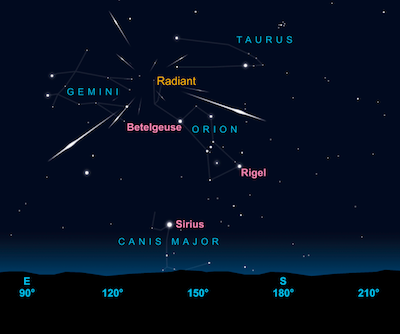
Orionids at their peak
BY MARK ARMSTRONG
ASTRONOMY NOW
Posted: 20 October 2013

The Orionids are probably the best of the crop of autumn (spring for the Southern Hemisphere) meteor showers - now that the Leonids have returned to their 'normal' level of activity - so it's a great shame that this year's show will be severely blighted by the presence of the almost full Moon almost at the radiant.

Credit: Astronomy Now graphic by Greg Smye-Rumsby
The Orionids are active normally between 16-30 October and have a broad peak, between Oct 21-24 in 2013. The Moon is just past full and homes in on the radiant, moving from Aries on the night of 20/21 to be situated very close to the radiant on the night of 23/24. The radiant lies north-east of Betelgeuse and a few degrees south west of gamma Geminorum.
From the UK and USA, the radiant is 30 degrees up by 2am local time and peaks at 50 degrees and 75 degrees (almost at the zenith from Houston) three or so hours later. From Sydney, the radiant is up by 3am and culminates in the northern sky 40 degrees up.
The Orionids are produced by debris shed by comet 1P/Halley and rates of 15 meteors per hour can normally be relied upon when the radiant is high in the south-east in the small hours. Halley orbited in a retrograde manner around the Sun and so do Orionids meteoroids, so they collide head-on with the Earth and have a fast atmospheric entry velocity of 67km/s. The effect of this is that many leave persistent ionisation trails which are always an amazing sight.
|



